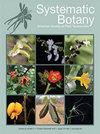Myriopteris grusziae: A New Species from Texas and Oklahoma Segregated from the Chihuahuan Desert Taxon M. scabra (Pteridaceae)
IF 0.8
3区 生物学
Q4 EVOLUTIONARY BIOLOGY
引用次数: 1
Abstract
Abstract Myriopteris scabra (until recently called Cheilanthes horridula) is a xeric-adapted fern species, endemic to the southwestern United States and northern Mexico. It is one of the most recognizable ferns in North America due to the unusual nature of the indument present on its adaxial leaf surfaces. This consists of rigid, multicellular trichomes with glassy, needle-like apices and compact conical bodies that are partially embedded in the leaf surface to form swollen, pustulate bases. Despite the seemingly distinctive nature of M. scabra, published chromosome counts indicate that collections assigned to this taxon encompass both diploids (n = 29) and tetraploids (n = 58). Here we investigate this case of cryptic diversity by integrating data from cytogenetic and spore analyses, observations of sporophyte morphology, and geographic distributions. Myriopteris scabra s.l. is shown to comprise two genetically disparate, morphologically recognizable taxa that exhibit little or no geographic overlap. The tetraploid taxon is described as a new species, M. grusziae, which completely supplants diploid M. scabra in the northeastern portion of its range (central Texas and south-central Oklahoma). This presumed allotetraploid is most like M. scabra but differs in having ultimate segments with adaxial trichomes that are longer, more flexible, mostly linear, and superficially attached. In addition, tetraploid M. grusziae has larger, more abundant scales that largely conceal the dark, sclerified leaf rachises, and it produces consistently larger spores than diploid M. scabra. We hypothesize that M. grusziae is an allotetraploid hybrid that acquired half of its chromosomes from M. scabra. However, the identity of the other diploid parent has yet to be resolved.从奇瓦瓦沙漠分类群M. scabra(翼蕨科)分离出的德克萨斯州和俄克拉何马州一新种
摘要:千足蕨(Myriopteris scabra,直到最近才被称为Cheilanthes horridula)是一种适应干旱的蕨类植物,美国西南部和墨西哥北部特有。它是北美最知名的蕨类植物之一,因为它的正面叶表面上存在着不寻常的成分。它由坚硬的多细胞毛状体组成,毛状体具有玻璃状的针尖,紧凑的圆锥形体部分嵌入叶表面,形成肿胀的脓疱状基部。尽管糙毛霉的性质看起来很独特,但已发表的染色体计数表明,分配给这个分类单元的集合包括二倍体(n = 29)和四倍体(n = 58)。在这里,我们通过整合来自细胞遗传学和孢子分析的数据,孢子体形态观察和地理分布来研究这种情况。研究表明,肉鸡属(Myriopteris scabra s.l.)包括两个遗传上完全不同、形态上可识别的分类群,它们很少或没有地理重叠。四倍体分类群被描述为一个新种,M. grusziae,它在其活动范围的东北部(德克萨斯州中部和俄克拉荷马州中南部)完全取代了二倍体M. scabra。这种假定的异体四倍体最像糙毛霉,但不同之处在于其末端的毛状体更长,更灵活,大部分是线性的,表面附着。此外,四倍体的毛霉有更大、更丰富的鳞片,这些鳞片很大程度上掩盖了黑暗、硬化的叶轴,并且它产生的孢子始终比二倍体的毛霉更大。我们推测,毛螨是一种异源四倍体杂种,其一半的染色体来自于毛螨。然而,另一个二倍体亲本的身份尚未得到解决。
本文章由计算机程序翻译,如有差异,请以英文原文为准。
求助全文
约1分钟内获得全文
求助全文
来源期刊

Systematic Botany
生物-进化生物学
CiteScore
1.80
自引率
10.00%
发文量
72
审稿时长
6-12 weeks
期刊介绍:
Systematic Botany Monographs is a series of peer-reviewed taxonomic monographs and revisions published the American Society of Plant Taxonomists. ISSN 0737-8211, ISBN prefix 978-0-912861. No; volumes of Systematic Botany Monographs must be ordered separately. ASPT membership inludes only a subscription to the quarterly journal Systematic Botany. SBM is supported by sales, author"s subsidies, and donations.
 求助内容:
求助内容: 应助结果提醒方式:
应助结果提醒方式:


